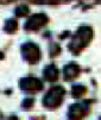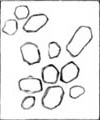Wood rot in
the Permian coniferous tree Plyophyllioxylon
Cell-size clots in a Permian tree trunk recently discovered and named Plyophyllioxylon hulstaiense
[1] have been interpreted as "spheroidal or ovoid shaped" coprolites,
with implications for "a previously unknown type of interaction between
woody plants and animals", although their outline is often polygonal
(Figs.1-3), which reveals their nature as cell casts.



Fig.1: Damaged tissue of Plyophyllioxylon with
cell-size clots, detail from [1], Fig.3C.
Fig.2,3: Angular cell-size clots, detail from Fig.1 and contours.
The publication [1] is one of several ones,
beginning with [2],
involving alleged coprolites which have turned out to be no such. R. Rößler
has blamed poor eyesight for his inability to tell apart small
angular shapes from rounded ones. Nevertheless he shuns any discussion
on the subject and continues calling angular clots spheroidal or
ovoid,
ignoring plain evidence.
Apparently every one of the authors [1] sticks to the
coprolite hypothesis in order to boost the waning credibility of
previous
publications involving oribatid mites. As a response to repeated criticism,
they prefer vague terms like "unknown creatures" and "new
detritivores" lately [1].
Erroneous publications on coprolites could have been avoided if a few
simple rules had been observed:
(1) Angular clots are no coprolites.
(2) Clots with shapes and sizes fitting to nearby cells are no
coprolites.
(3) Clots inside cells are no coprolites.
(4) Clots arranged in chains and files fitting to the tissue are no
coprolites.
These rules, nearly trivial as they seem but once widely ignored,
hopefully will end the series of publications confusing wood rot with
herbivore activity and deriving conclusions on ecology.
More misinterpretations due to lack of thoroughness can be found out and removed by critical analysis of palaeobotanical work. This gives rise to hope that the fraction of erroneous results will be reduced.
H.-J.
Weiss 2013
[1]
Zhuo Feng, Jun Wang, Lu-Yun Liu, R. Rößler: A
novel coniferous tree trunk with septate pith from the Guadelupian
(Permian) of China:
Ecological and evolutionary
significance.
Int. J. Plant
Sci. 173(2012),
835–848.
[2] R.
Rößler:
The late palaeozoic tree fern
Psaronius - an ecosystem unto itself.
Rev. Palaeobot.
Palyn. 108(2000), 55-74.
|

|
 20 20 |

 20
20



 20
20